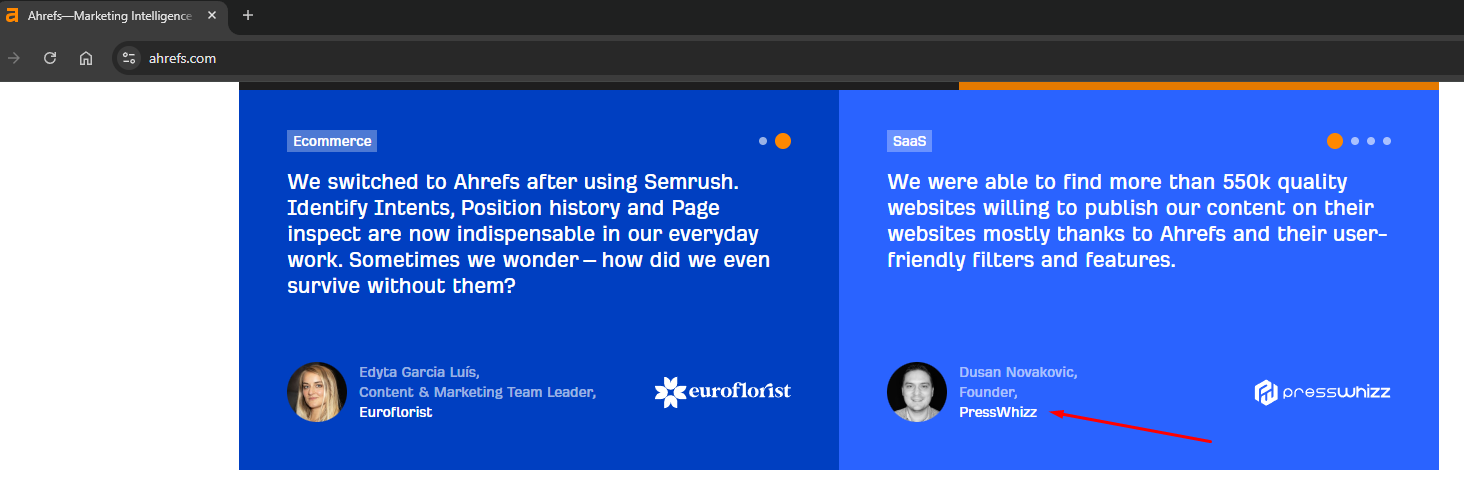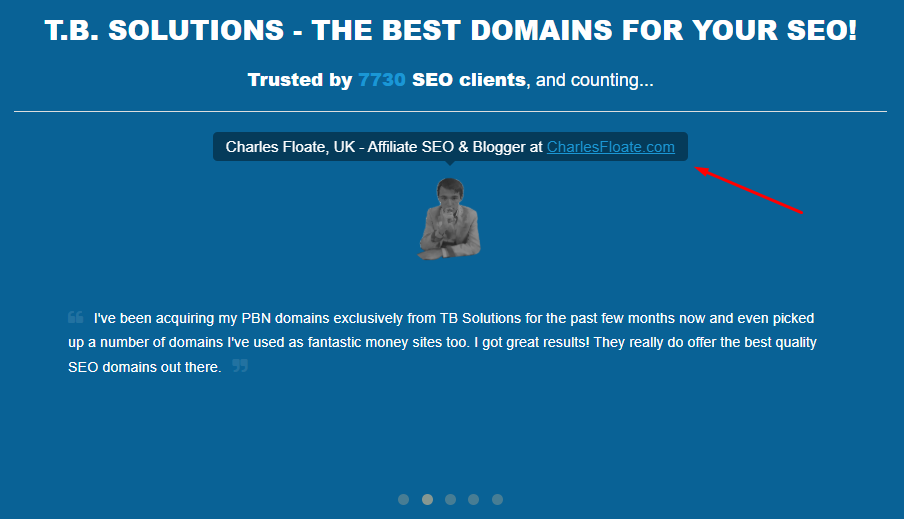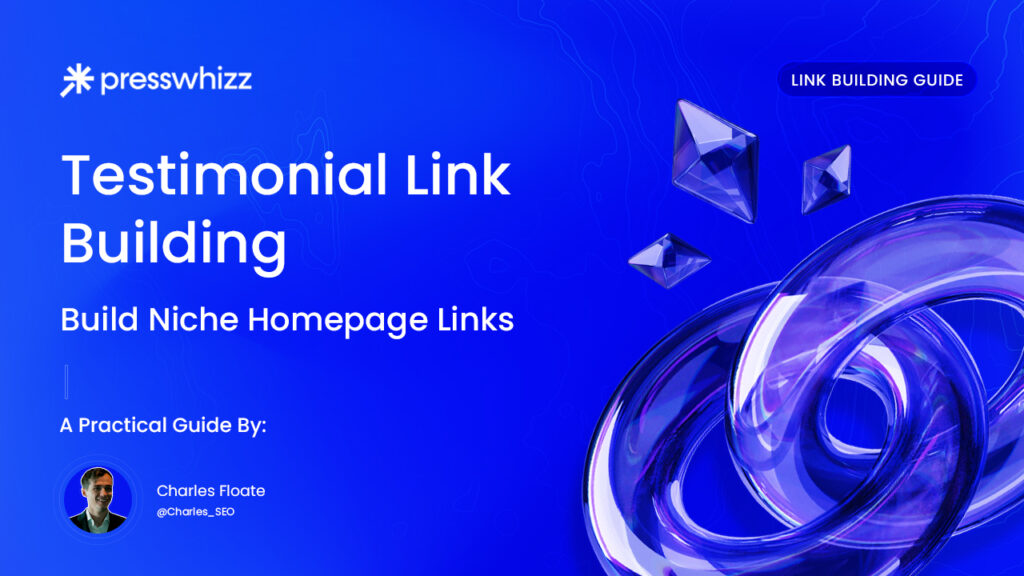It’s simple. It’s scalable. It’s white hat. And when done right, it lands you DoFollow homepage links from high DR sites in your vertical, without needing to write 1,500 words of fluff or chase editors for months…
In fact, if you or your client are already buying within your industries ecosystem: Think SaaS tools, plugins, CRMs or even manufacturers in your niche, you could start building these links in the next 30 minutes.
This isn’t theory either.
We’ve landed homepage links from DR90 SaaS brands, DR80 hosting providers, DR70 content tools, and all just by offering honest feedback and a helpful testimonial. In fact, our CEO managed to put us on one of the most coveted homepages in SEO with this exact tactic –

We’re talking about:
- Niche relevant, often contextual homepage links ✅
- Huge trust and entity wins ✅
- And in some cases, recurring referral traffic + conversions
So in this post, we’re going to break down:
-
How testimonial link building works in 2025
-
Why it’s still criminally underused by almost everybody in SEO
-
How to do it properly (without looking desperate)
-
How to scale it with automations, email SOPs, and AI
-
How to turn it into a long term authority play for your brand
And they are 100% FREE.
What Is Testimonial Link Building?
Testimonial link building is the process of getting a backlink by offering a written or video testimonial to a business, tool, service, or platform that you already use, in exchange for being featured on their site (usually on the homepage or a dedicated testimonials/reviews page).
And when your testimonial includes a link back to your business, you’re now riding the trust coattails of a niche relevant, high authority site.
Think of it like digital social proof plus a contextual link.
It’s a double win: The company gets validation and conversion value from your testimonial, and you get a high value backlink with built-in relevance and trust.
That’s why this isn’t some gimmick. It’s a legitimate, scalable, and brand-safe way to build links that can outrank entire guest post and PR campaigns! And if done properly, you can make your offer impossible to say no to.
Why Testimonial Link Building Works
When a company features your testimonial, they’re not doing it for SEO. They’re doing it for CRO (conversion rate optimization). Your link becomes a byproduct of a genuine business relationship, not a transaction.
That means:
- Google and the human raters seem them as natural ✅
- You don’t raise red flags with spammy anchor profiles ✅
- The page lives on for years (especially on homepages) ✅
I’ve had this homepage link from TBSolutions for nearly a decade now –

These are often manually built homepage links on some of the most trusted domains in your niche. And testimonial links exist for a real business reason. That makes them almost bulletproof from manual reviews and penalties.
💣 Pro Tip: Want to strengthen the legitimacy of the link even more? Include your as much information as you can! Try to go beyond just a headshot, brand logo, and job title. The more real it looks, the more value it adds to them, and the more likely it sticks forever.
How To Find Testimonial Link Opportunities
Most SEOs treat testimonial link building like a one-off, they fire off a single quote to a SaaS tool and pray for a backlink. That’s not how you scale this technique and jack up your authority metrics by a few dozen points in a week.
The smart operators build an internal SOP for sourcing testimonial opportunities every quarter, systematize the pitch process, and turn it into a passive homepage link farm for every brand, site, or client they touch.
Here’s the exact 5-step process we use at PressWhizz to find these link opportunities with military precision:
Step 1: Build a List of Tools, Vendors & Platforms You Use or Have Used
Start with what’s already in your ecosystem, because nothing beats warm context.
Go through:
- Your monthly SaaS expenses
- All tools listed on your site’s footer or stack page
- Plugins, themes, hosting providers, and CRMs
- Any freelancers, contractors, or agencies you’ve worked with that will let you use their name
- Productized services you’ve used for design, SEO, or dev work
- Manufacturers or white-label suppliers if you’re in eComm
💣 Pro Tip: Ask your clients for this list too. Agencies can mine 20–30 testimonial link opps just from a single local business client’s vendors (If you want to expand even outside your niche, think: POS systems, delivery software, insurance brokers, etc).
Then build a simple table to track:
| Tool/Service | Used By | Website | Contact/Support | DR | Link on Testimonials? (Y/N) |
You’re not just building a pitch list, you’re building a link asset vault.
Step 2: Check If They Already Feature Testimonials With Links
Before you pitch anything, you need to know if they actually give links in the first place.
Use search footprints like:
site:productdomain.com intitle:testimonials
site:productdomain.com inurl:testimonials
"[product name] testimonial" + "CEO"
"[product name] review" + "headshot"
What you’re looking for:
- Do they link out to customers?
- Do they show headshots, job titles, or company names?
- Are the testimonials sitewide (e.g. in footers, homepages)?
- Are they contextual or buried in a testimonials page?
💣 Pro Tip: Plug the site into Ahrefs → Best by Links → filter URLs for “testimonial” or “review.” This shows you which testimonial pages already attract links, aka, prime real estate.
Step 3: Filter by Domain Authority & Relevance
You don’t need to pitch every WordPress plugin you’ve ever used. Focus on testimonial pages from domains that are:
- DR 40+
- Have at least some organic traffic (500+/mo is ideal)
- Are in your niche or serve the same audience
- Already link out from the testimonial (not just mention)
We want links that boost trust, topicality, and equity, not just logos on a vanity wall.
💣 Pro Tip: Bonus points if they’re ranking for branded or commercial terms in your niche. This turns your testimonial into a link and referral traffic play in one move.
Step 4: Identify the Decision Maker or Marketing Contact
Most testimonials don’t go through support, they go through content, marketing, editors, developers or partnerships.
Here’s how to find the right contact fast:
- Search
[company] + marketing manager + LinkedIn - Use Clearbit or Hunter.io to find verified emails
- Check their site’s About or Team page
- Or just reply to support and ask: “Who handles case studies or testimonials?”
You’re not asking for a backlink, you’re offering a win-win value trade.
And that makes the pitch land smoother than 99% of SEO outreach.
Step 5: Prioritize With a “Linkability Score”
Now that you’ve got 20–50 potential targets, it’s time to triage.
Create a simple scoring system:
| Brand | DR | Homepage Link? | Relevant to Niche? | Open Testimonials? | Score (1–10) |
|---|---|---|---|---|---|
| SurferSEO | 81 | Yes | Yes | Yes | 10 |
| TinyToolX | 35 | No | Kind of | No | 4 |
Focus first on building the 8-10s. These are your high probability + high value targets, and when you send your pitch, you’ll be backed by real usage, context, and ROI.
How to Write a Testimonial That Lands the Link (Every Time)
If your pitch sounds like:
“Great tool, super easy to use! Helped my business a lot :)”
You’re never getting a link, at least not from any site worth it.
Why? Because generic praise does nothing for the brand. They can’t quote it. They can’t showcase it. And they sure as hell won’t give you a homepage DoFollow for a 10-word one-liner they’ve heard 9,000 times…
If you want a link, your testimonial needs to:
Build trust for their product ✅
Include specific outcomes or benefits ✅
Position you (or your client) as a legitimate business ✅
Be quotable and short enough for hero sections ✅
Subtly justify the backlink without sounding like a pitch ✅
Here’s the framework:
Step 1: Start With Credibility
You want to immediately answer: “Why should this person’s words matter?”
Start with your title, role, or brand credibility. Don’t make them Google who you are.
“As the founder of a boutique SEO agency managing over 40 client campaigns…”
“Running an eCommerce brand in the brutally competitive cryptocurrency niche…”
“After testing 12 tools and 9 different CRMs for our B2B sales team…”
Boom. You’ve just established authority. They’re now invested in what you say next.
Step 2: Call Out the Specific Win
You need to describe the benefit with measurable impact.
Not just “great tool”, give them something they can repurpose in their own content.
“…SurferSEO helped us cut 30% off our content production time while actually ranking faster.”
“…Switching to XYZ Hosting reduced our checkout load time by 1.2 seconds and lifted our conversion rate by 8%.”
“…Using BrandMonitor, we recovered over 140 unlinked mentions in 60 days — all automated.”
💣 Pro Tip: Use numbers, percentages, or specific actions. Specific = believable = link worthy.
Step 3: Naturally Include Your Brand
Now, drop your brand name naturally into the testimonial. This is where the backlink gets justified.
“I’d recommend [Tool] to any agency looking to scale like [YourAgency.com] has.”
“…it’s now one of the core tools we list on [BrandSite.com] for all new team members.”
“…even our junior writers at [BlogName.com] got results with no training.”
You’re not asking for a backlink. You’re giving them a quote that requires one to make sense.
If they want to include your brand as the source? The link is almost automatic.
Step 4: Provide Options (Text + Video + Headshot)
If you want to 10x your success rate, do their job for them.
When you send your testimonial, include:
- A 2-3 sentence text version.
- A 30-60 second Loom or webcam video (hosted on your end or unlisted YouTube).
- Your headshot.
- Your name, title, brand, and URL.
- Bonus: Company logo or icon if relevant.
This makes it frictionless for them to drop it on their homepage, footer, case studies, or dedicated testimonial carousel.

And video testimonials do particularly well, especially with marketers.
Step 5: Don’t Beg, Just Offer Value in Your Pitch
The email pitch itself should be short, structured, and value first.
Here’s a proven template:
Subject: Quick testimonial (with video) from a long-time user Hi [Name], Just wanted to say — we’ve been using [Tool/Product] for [X months/years] and I wanted to share a quick testimonial since it’s been a game-changer for [Result]. Here’s a short quote, headshot, and even a quick video if you want to use it anywhere — no pressure at all, just figured it could help your conversion pages. “[Drop your testimonial here — ideally 2-3 sentences, brand mention included]” [Your Name] [Your Position] - [Company Name] [URL] Headshot: [link] Logo: [link] Video (optional): [link] Thanks for building a solid product — happy to chat if you need anything else!
How to Scale Testimonials Like an Outreach Campaign
You can treat testimonial link building like a one time PR play… Or you can build it into a full blown outreach funnel that runs on SOPs, tools, and automation.
If you’re managing multiple clients, verticals, or projects, or just want to consistently acquire niche homepage links without burning out your team, here’s how to scale it.
Step 1: Build a Pre-Qualified “Products We Use” Database
Start internally.
List out every tool, plugin, platform, vendor, service provider, manufacturer, and subscription your business already uses.
Create a sheet, include columns for:
-
Product Name
-
Use Case
-
URL
-
Has Testimonial Page? (Yes/No)
-
Homepage Link Potential? (Yes/No)
-
Testimonial Sent? (Yes/No)
-
Response?
-
Live Link URL
Google Sheets is fine for this, Airtable is better!
Step 2: Expand With Client Tech Stacks + Partners
Now scale it sideways.
If you’re an agency or consultant:
-
Ask each client for a list of the tools they use
-
Review their Shopify apps, WordPress plugins, CRM integrations
-
Look at suppliers or B2B vendors they’ve worked with
You now have access to dozens of other testimonial opportunities per client, all of which can be used to build links either to your client or through you as their “marketing partner.”
This works even if your name isn’t on the testimonial. You can credit it to their founder, marketing head, or even a team lead.
Just make sure they’re cool with it before you use their name…
Step 3: Automate Site Discovery & Qualification
Once you’ve got a huge list of tools, plug them into automation to speed things up.
Use tools like:
-
ScraperAPI / Hexomatic – Check for testimonial pages on target sites
-
Screaming Frog + Custom Extraction – Search for anchor patterns like “what our users say” or “testimonials”
-
ChatGPT / Claude + Google Sheets – Generate outreach messaging variations, pitch personalization, and test quote copy
You’re looking to tag each domain with:
-
Is there a testimonial section?
-
Are testimonials on the homepage?
-
Do they link back to users?
-
Do they accept video / image / text?
Build filters into your Airtable or Sheet to prioritize.
Step 4: Use Templated Outreach With Personalization Hooks
You want to run this like a real campaign, but one that actually gives value.
Set up your automated sequence:
-
Day 1: Initial pitch (testimonial offer + quote).
-
Day 3: Follow-up with optional video or graphic testimonial.
-
Day 6: Final nudge, include permission to use headshot/logo.
Use tools like:
-
GMass / Mailshake / Instantly.ai for personalized cold outreach.
-
Lemlist if you want to embed video/headshots inside the pitch.
-
Custom GPTs for auto-spinning templates around each product’s main benefit.
Here’s a sample follow-up line that works well:
“Just wanted to bump this up in case your team’s working on homepage case studies or landing page tweaks this month. The quote is yours to use however you like though!”
You’re reminding them that you’re helping their marketing, not chasing a link.
Final Thoughts:
Most link building tactics chase a fabricated reason to justify the link. This one is the reason. No tricks, no bait-and-switch. Just honest feedback, built into their sales funnel, which happens to carry your brand and your backlink right along with it.
But here’s the part most SEOs don’t think about… The biggest ROI in testimonial links isn’t just the homepage DoFollow. It’s what comes after.
Because the more links you get this way:
-
The easier it is to land partnerships with those brands.
-
The more likely your brand shows up on their case studies, integrations, newsletters.
-
The more authority and legitimacy you build, especially in “trust-first” verticals like SaaS, finance, health, or info products.
- The more other companies, brands and influencers see you.
Testimonial link building isn’t just a tactic. It’s a bridge into bigger relationships. The kind of stuff that lands you JV deals, podcast invites, and cross promotions down the road.
And all it takes is a little time, a spreadsheet and a few honest words.



